Pie Crust Recipe
This post may contain affiliate links. Please read my disclosure policy.
Learn how to make a pie crust from scratch that’s flaky, buttery, and delicious with my pie crust recipe, tips, and video! This favorite family recipe turns out perfectly every time and makes the best pie crust for sweet and savory pies!
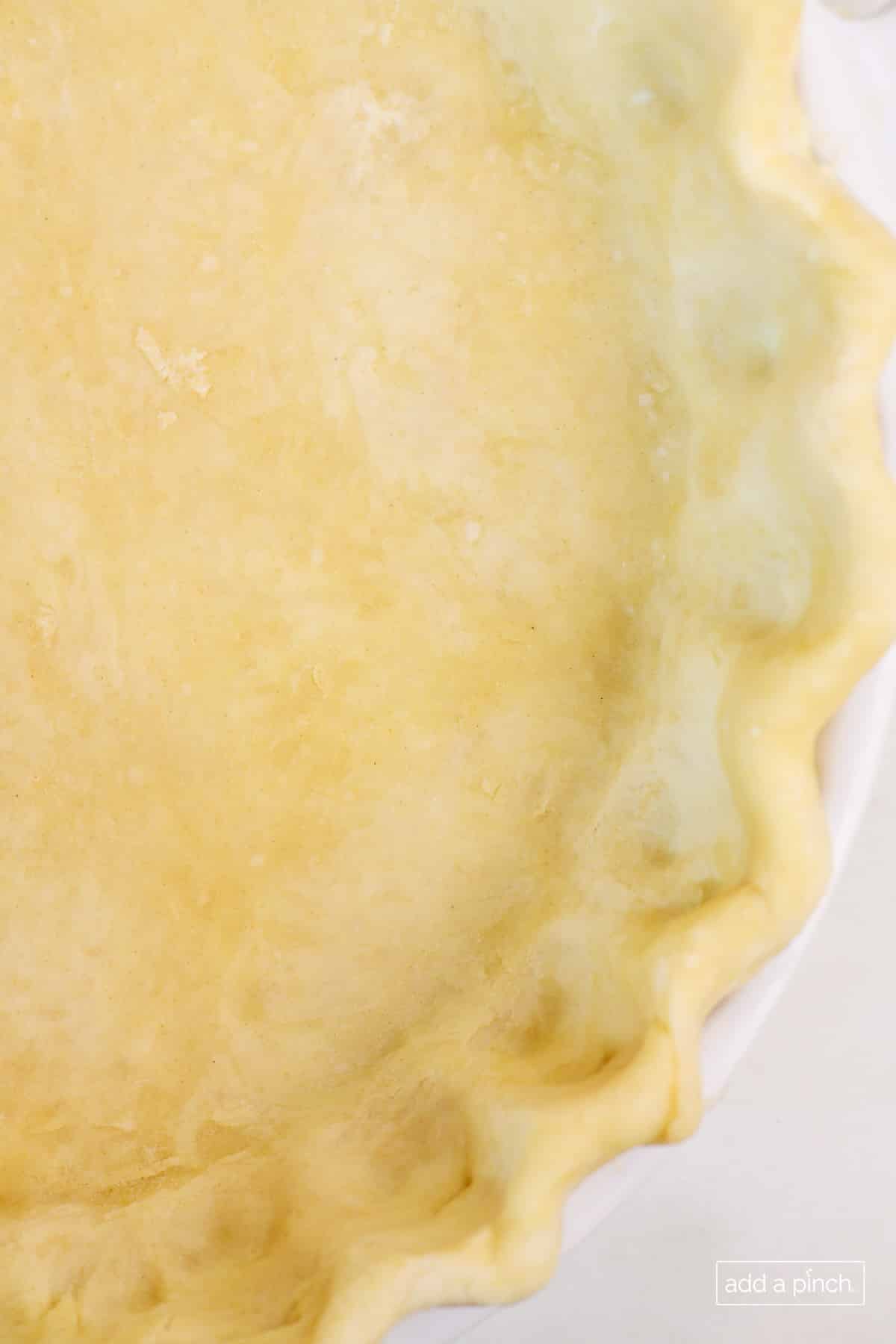
This pie crust works perfectly with savory or sweet pies, is made using butter and shortening for the flakiest crust (with the option of an all-butter pie crust), and is so easy to make! This pie dough rolls out easily and holds up well when baked. Once you try it, you’ll see why this has been a family favorite recipe for generations!
I will tell you exactly how to make it, give you tips to make it super simple and fail-proof, and have a video to see exactly how I make it! You’ll be baking pie crusts in no time!
I love making my homemade pie crust – I find it relaxing! I use it in my Pecan Pie, Apple Pie, and my Sweet Potato Pie, to name a few!
It leads the trio of favorite crust recipes, including my Graham Cracker Crust and Shortbread Crust.
Growing up, I watched my mother and grandmother make pie crusts as if they were the easiest thing in the world. They explained it all to me when I was older and ready to bake my own pies – and it was as easy as they made it look! I’m sharing that simple, fail-proof method with you in this recipe.
This pie dough recipe makes enough for a single-crust pie. You can double the recipe to make enough for a double-crust pie, lattice-crust pie, or a pie with a crust bottom and a crust top.
Here’s how you’ll make it.
Pie Crust Ingredients
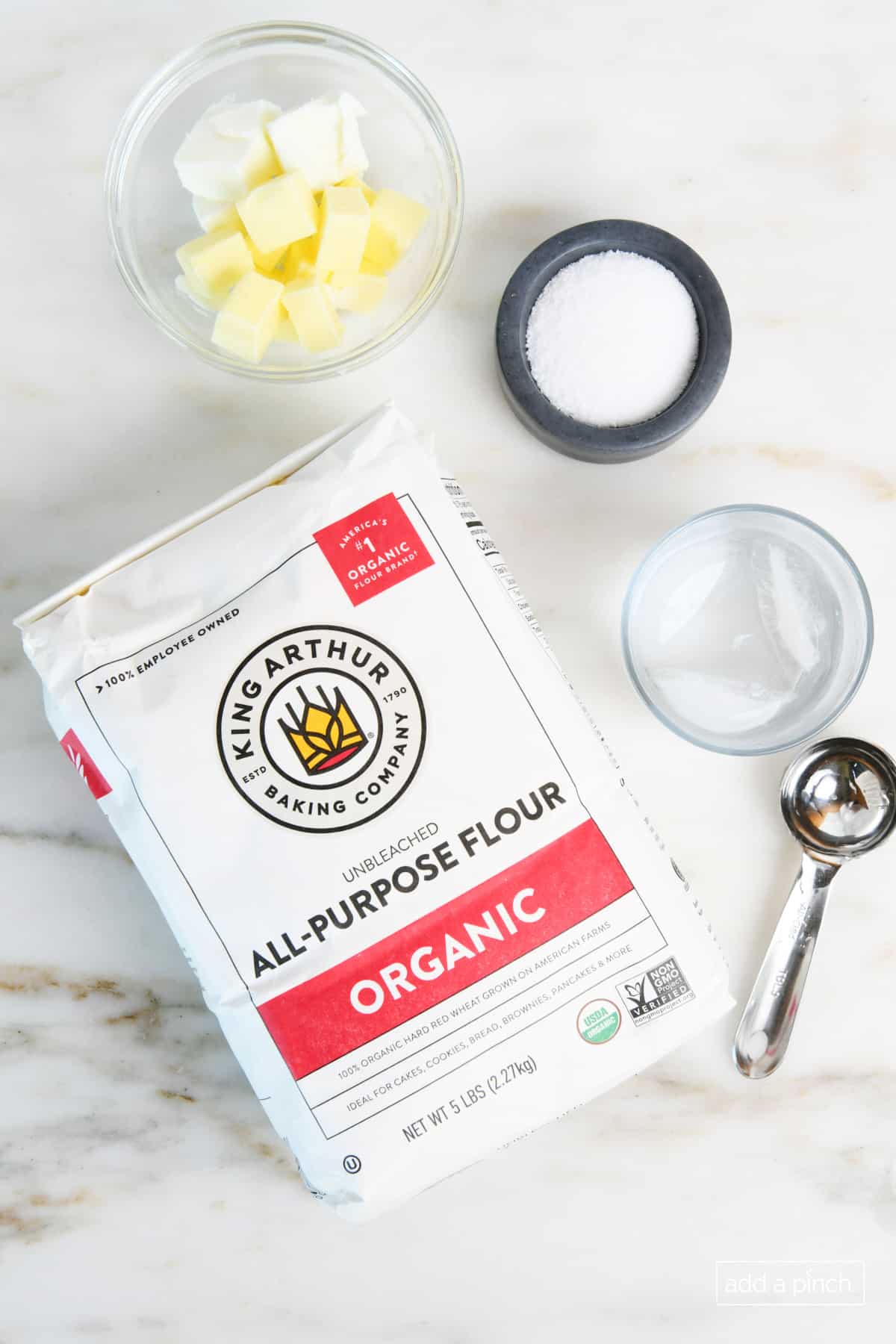
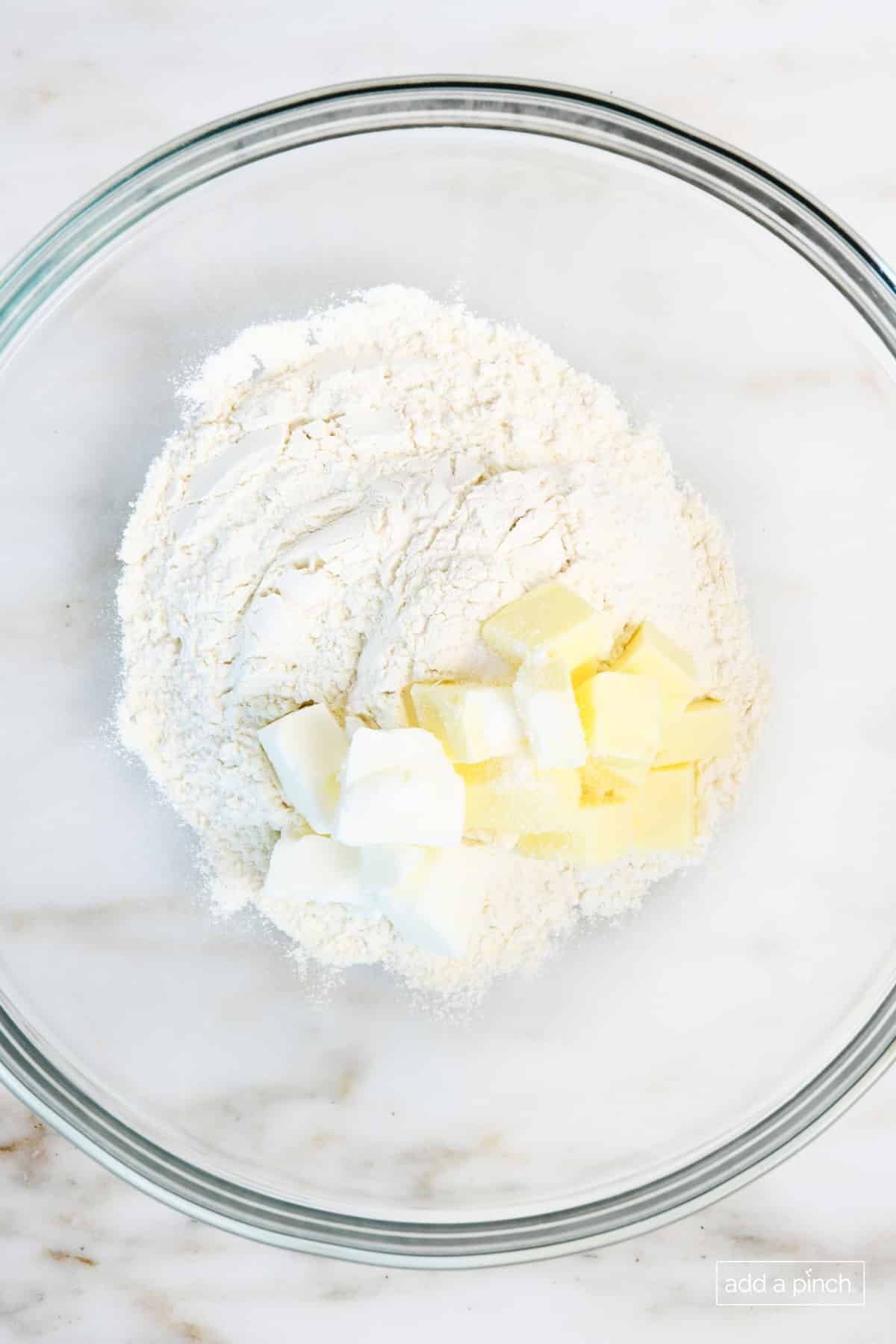
Be sure to see the recipe card below for the full listing of ingredients, instructions, notes, and estimated nutritional information.
- All-purpose flour
- Butter (cold) – cut into cubes
- Shortening (cold) – cut into cubes
- Salt – enhances the flavor of the pie dough
- Ice cold water – helps the ingredients to come together to make the pie dough. I use ice cubes in the water so it’s as cold as possible.
TIP: Make sure the butter and shortening are COLD, and you are using ice-cold water! Cold fats work to make the flakiest pie crust! If the butter or shortening is too warm before the pie dough goes into the hot oven, it can lose its flaky texture and result in a tough, greasy crust instead of a light, tender, and flaky one!
How to Make Homemade Pie Crust Recipe
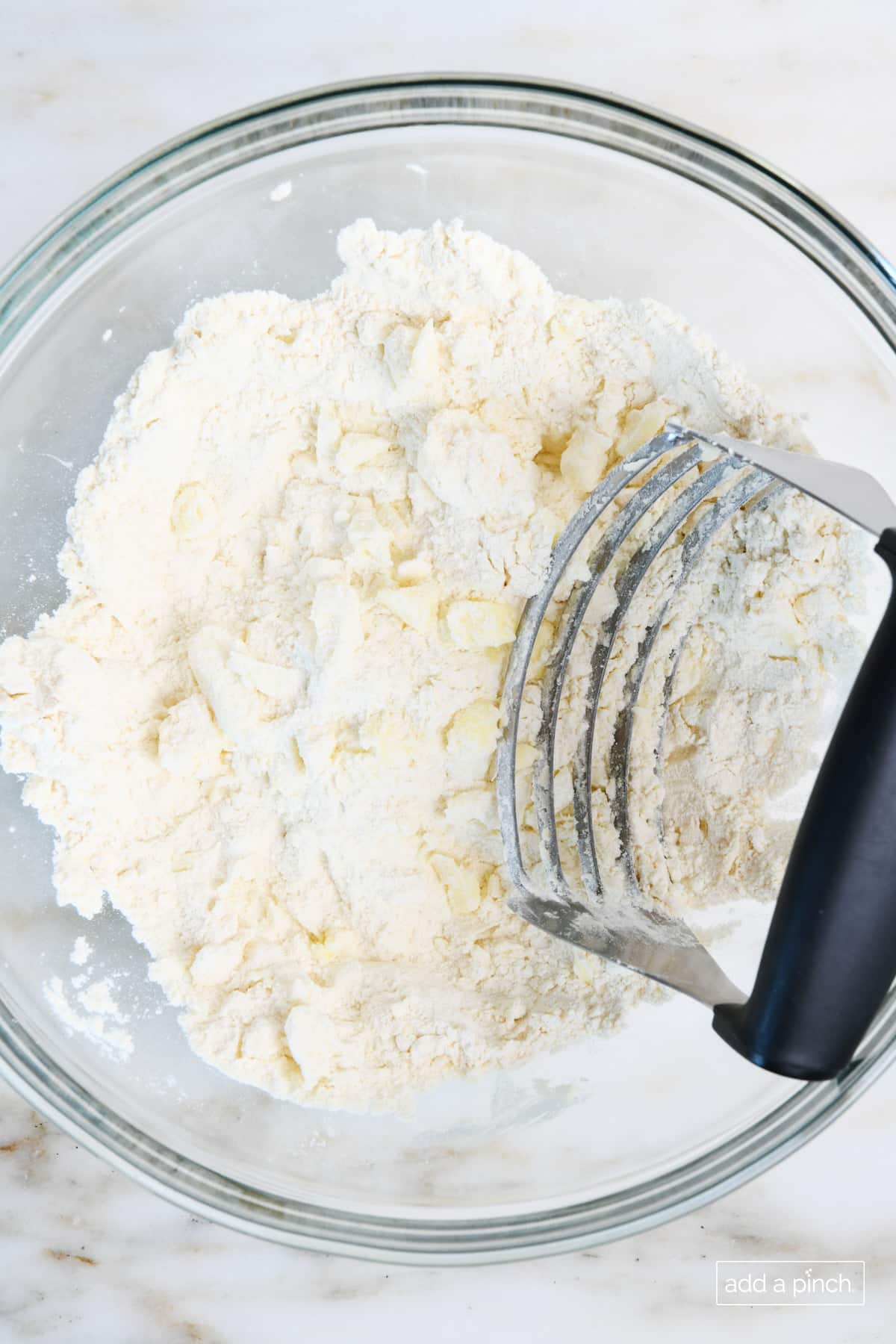
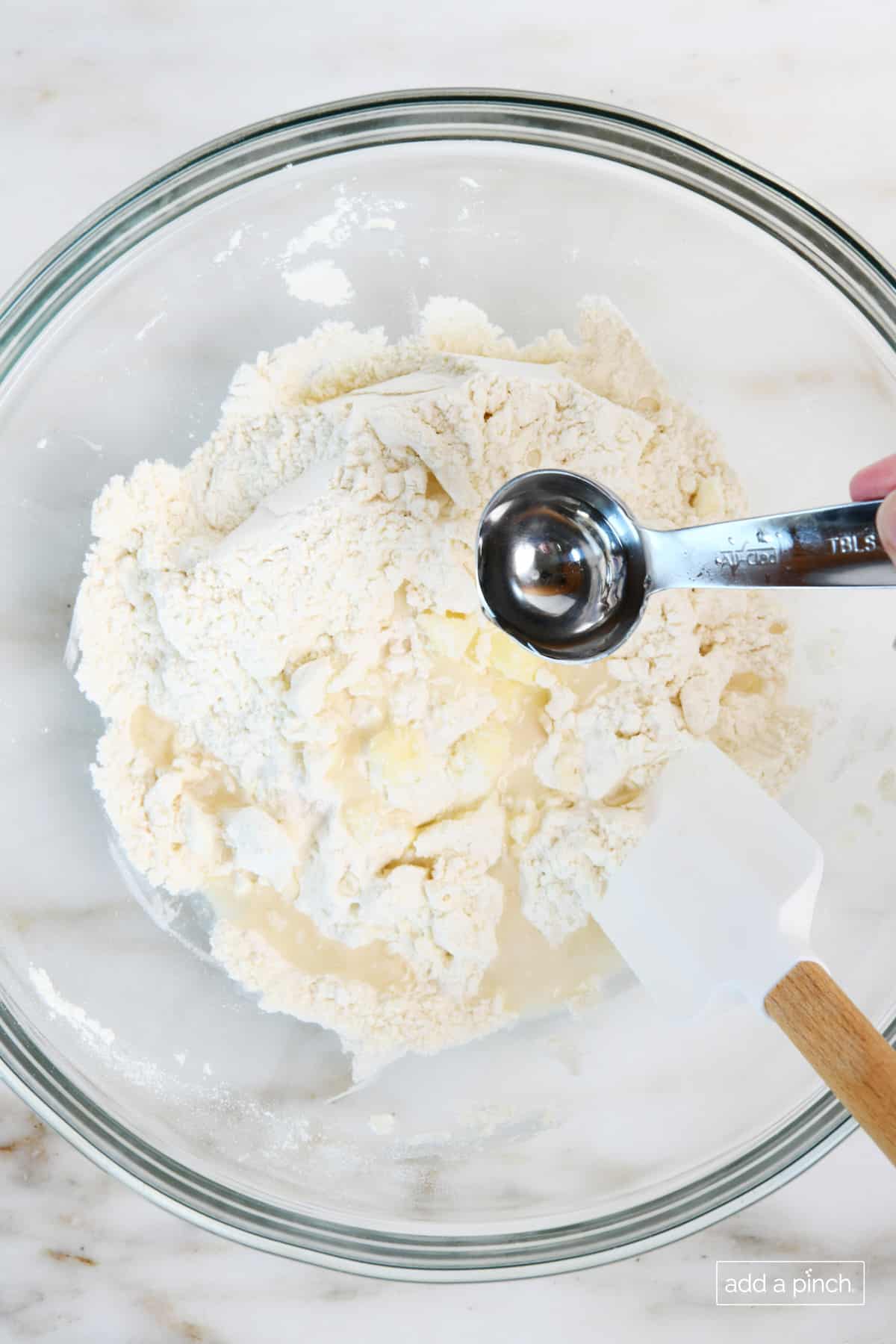
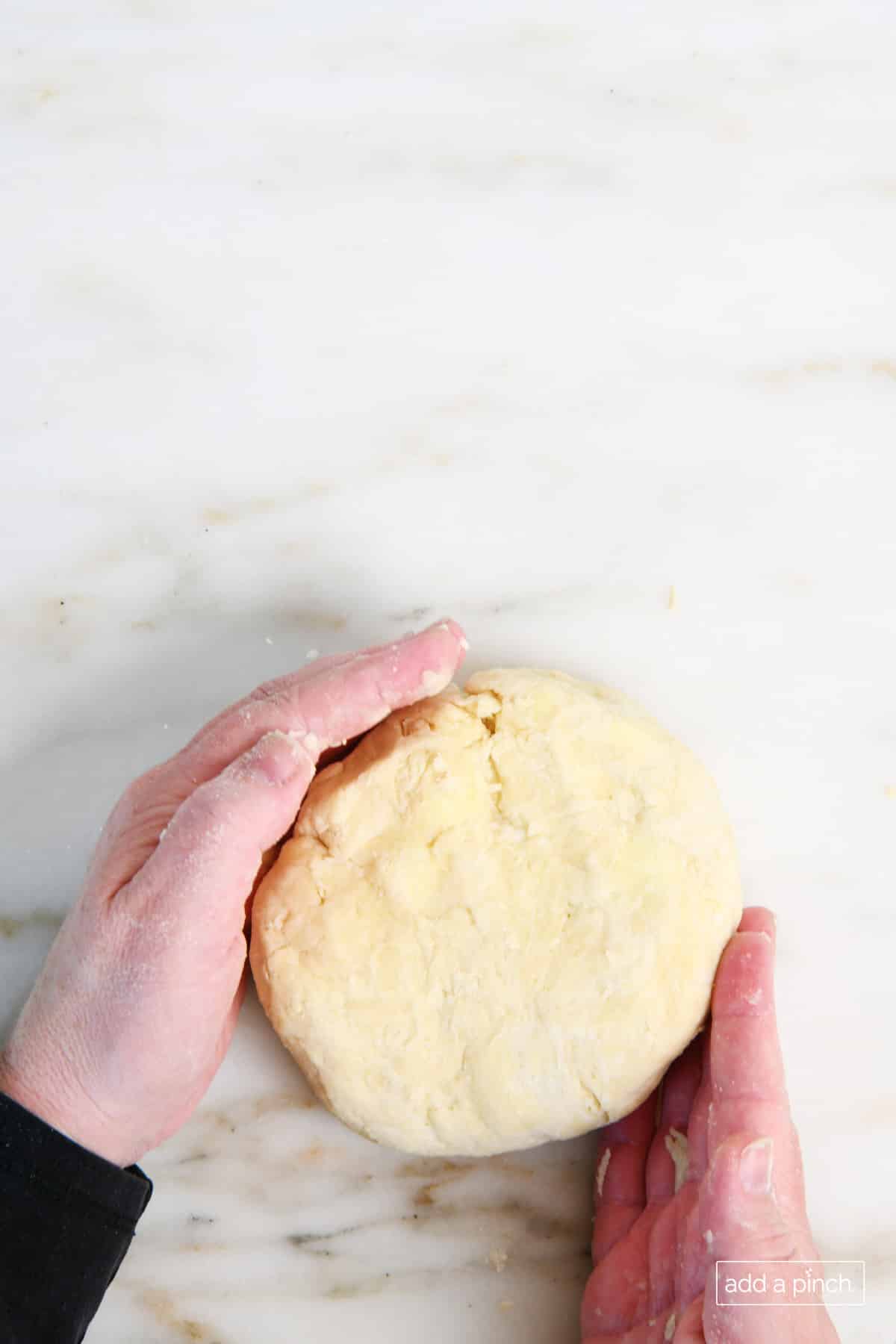
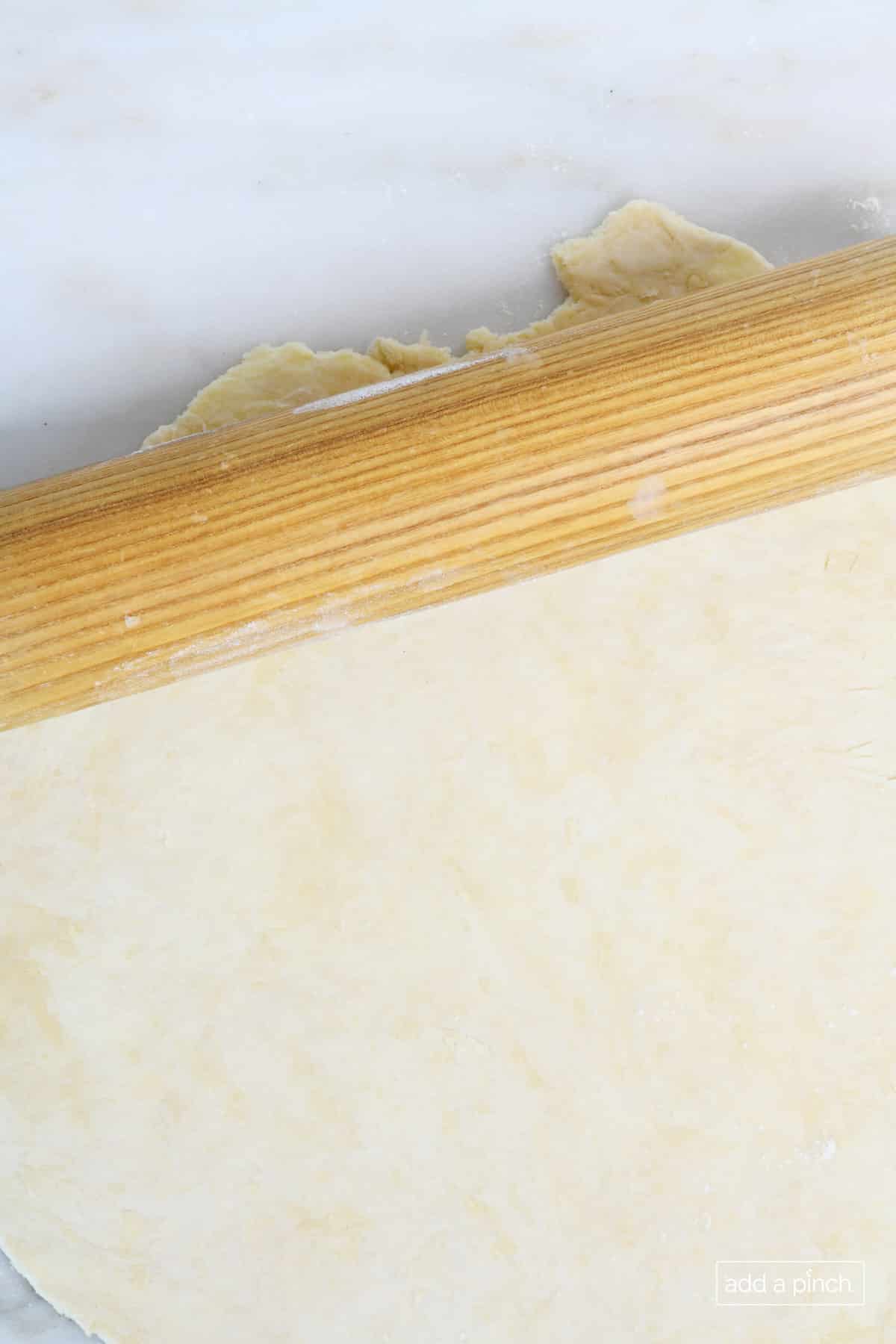
Prep. Butter a 9-inch pie plate and set aside.
Prepare the pie dough. In a large bowl, combine the all-purpose flour and salt. Cut in butter and shortening with a pastry cutter or two forks until the mixture resembles a coarse meal, coarse crumbs, or has pea-sized pieces of butter and shortening.
Add ice water. Gradually add enough ice-cold water (a tablespoon at a time) while mixing with a wooden spoon until a ball of dough is formed.
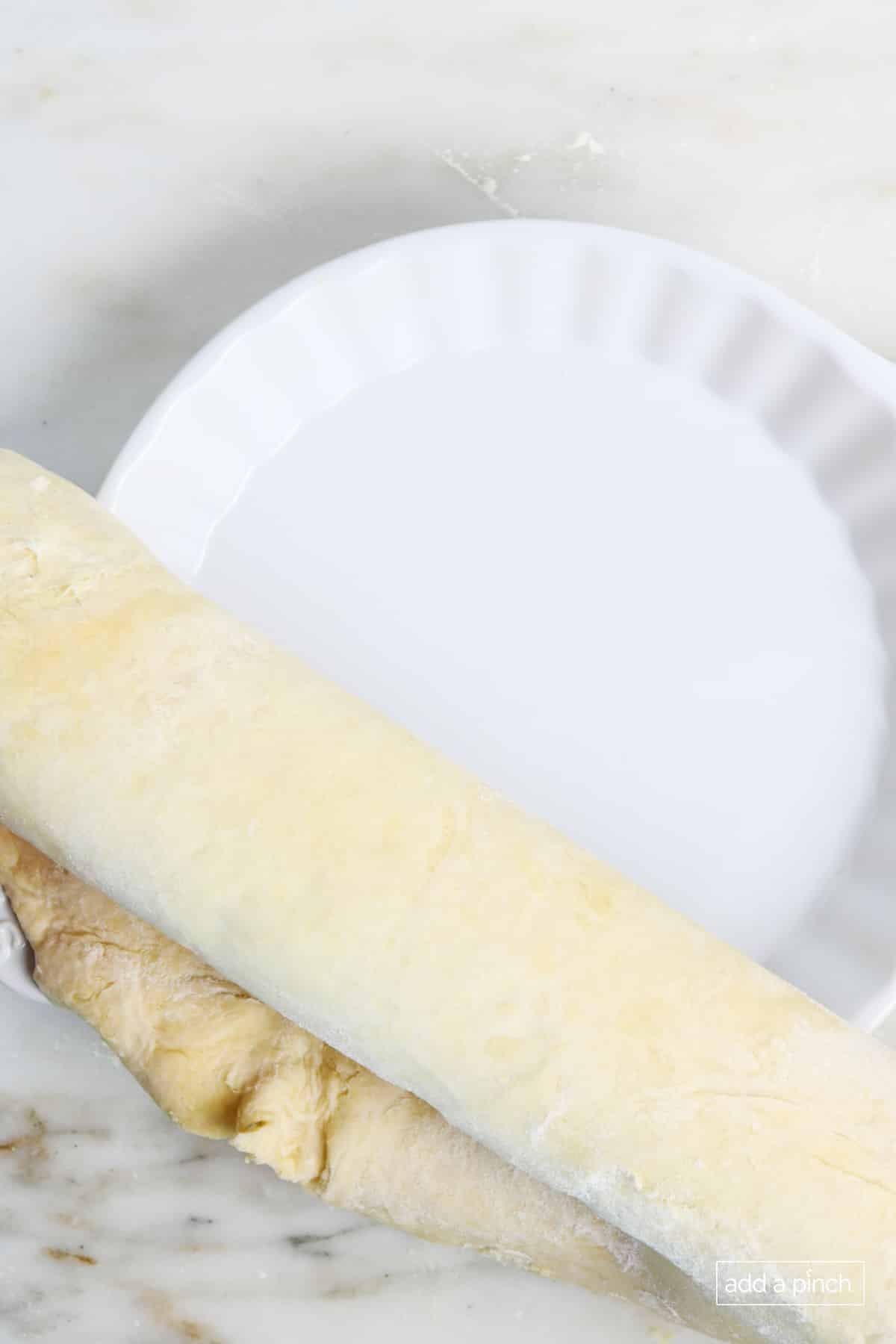
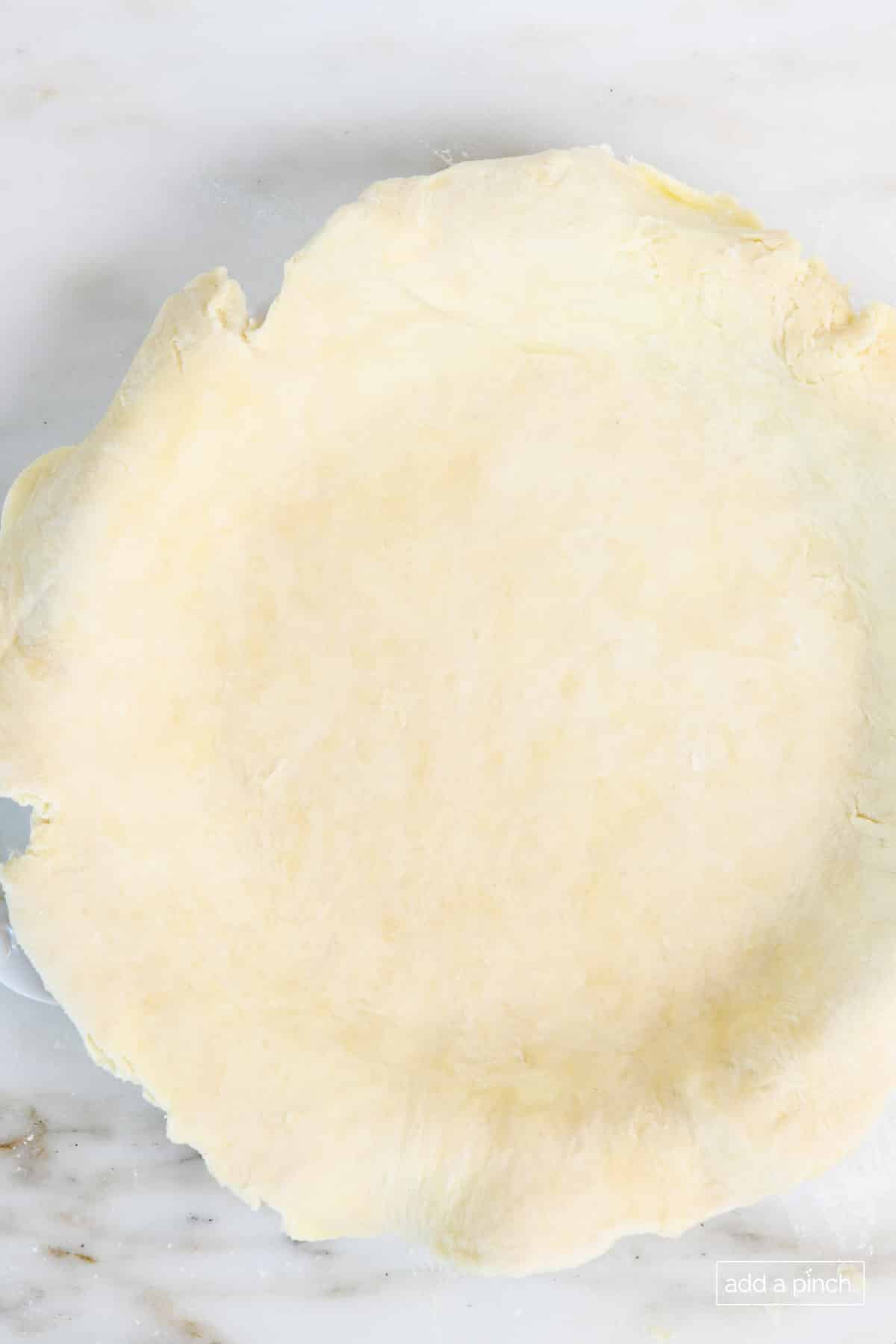
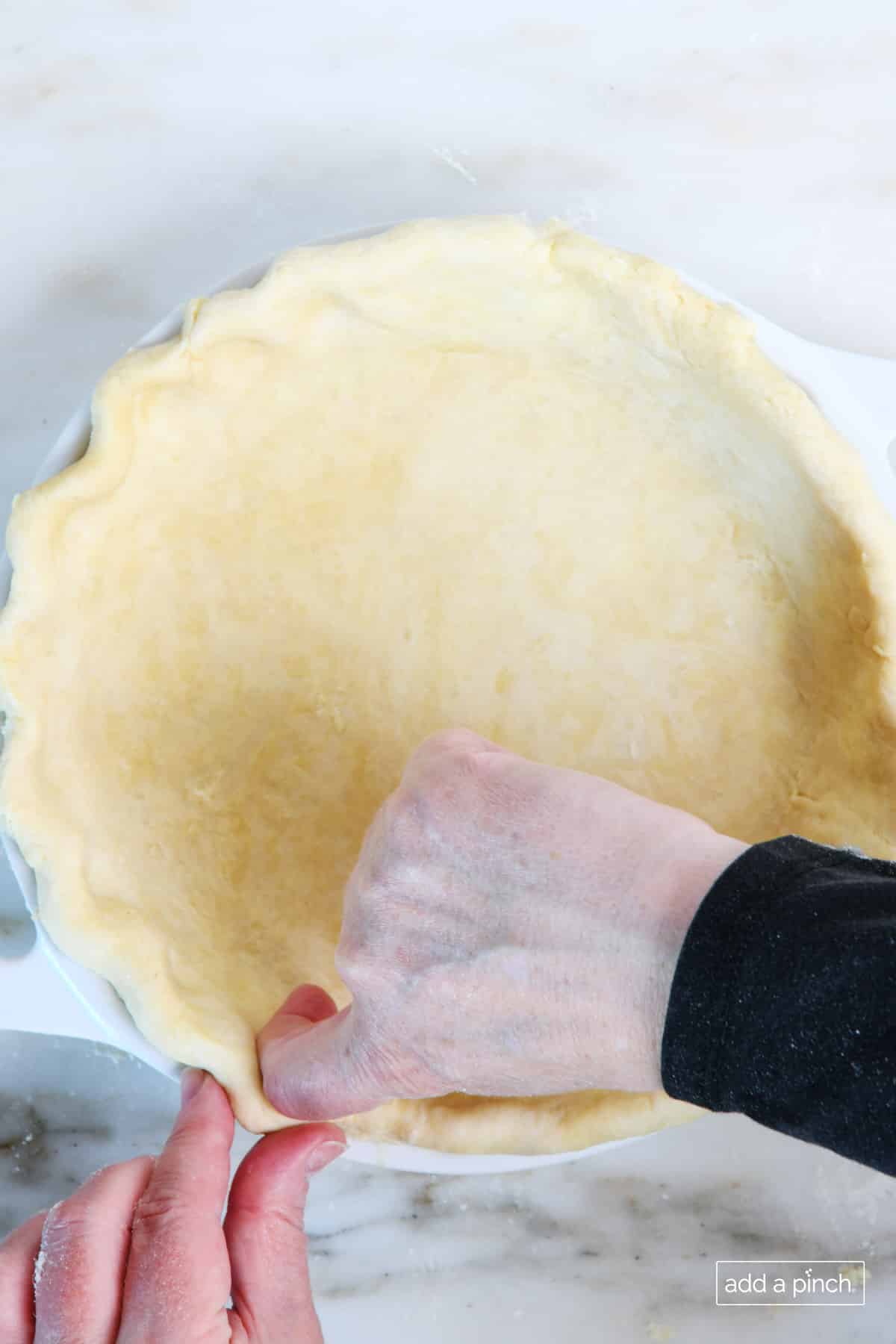
Transfer the dough to the pie plate. Remove the bottom piece of the plastic wrap, fold the dough over and lay it across the pie plate, and remove the top piece of the plastic wrap. Press the pie dough lightly into the bottom and sides of the pie plate. Crimp the top edges.
Chill the pie dough. Cover the pie plate with a piece of plastic wrap and place in the freezer for at least 30 minutes to overnight to chill. By freezing the fat in the pie dough, the crust will be flakier when baked, even more so than if you chill the pie dough in the refrigerator.

Fill and bake. Then, fill your pie dough with your chosen sweet or savory pie filling and bake it according to the pie recipe.
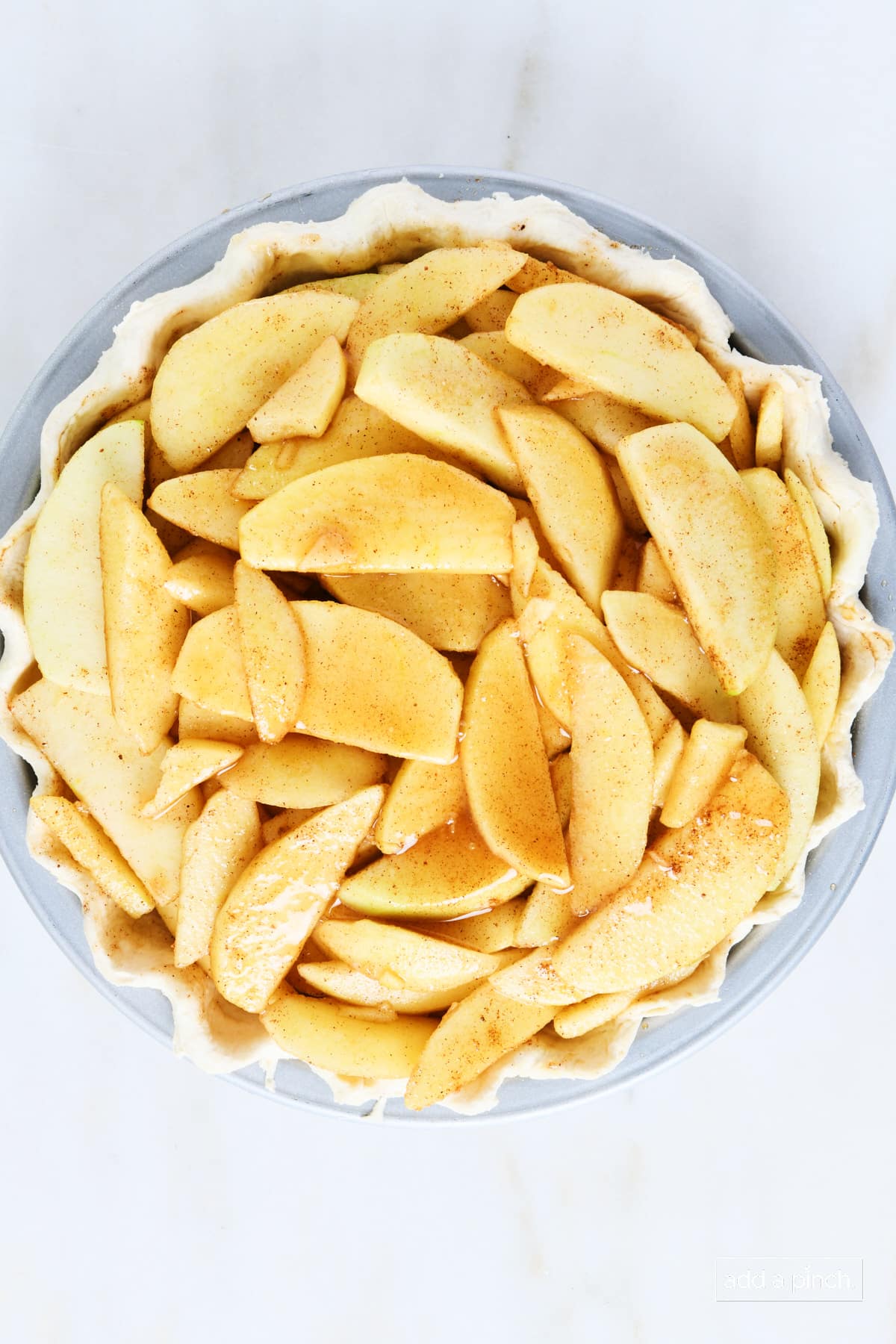
Bake and Serve. After baking your chosen pie according to that recipe, cool as instructed, then slice and serve. You’ll love how tender, flaky, and buttery it is!
Storage Tips
To make ahead. Prepare the dough as directed and place it into a freezer-safe pie plate. Wrap well with freezer-safe plastic wrap topped with aluminum foil and freeze for 30 minutes to overnight. To use, remove from the freezer and add your pie filling. Bake according to the recipe instructions. If a blind-baked pie crust is needed for the recipe, follow the directions included in the section How to Blind Bake Pie Crust.
To freeze for a longer term. Prepare the dough as directed and place it into a freezer-safe pie plate. Wrap well with freezer-safe plastic wrap topped with aluminum foil and place into the freezer for up to 6 months. To use, remove from the freezer, add your pie filling, and bake according to the recipe instructions. If blind baking, follow the instructions in the section How to Blind Bake Pie Crust.
Why Use Both Butter and Shortening in Pie Crust?
I love to use BOTH, as you’ve seen me describe! Here are some benefits of using both butter and shortening in your pie crust:
- Shortening – The shortening helps it to be super flaky, tender, and sturdy. It also helps the crust be somewhat flexible as you roll and shape the dough and hold its shape as it bakes in high heat.
- Butter – The butter gives it a delicious flavor and flaky texture! While an all-butter crust is delicious, it may not hold its shape as well as a shortening/butter crust.
- Combination of Butter and Shortening – This produces a delicious, flaky, yet perfectly sturdy crust for even heavier pie fillings. It’s how my grandmother made pie crusts for decades, and I love this method for my crusts too!
How to Make All Butter Pie Crust
Use 1/2 cup of butter plus a bit more to butter your pie plate. Omit the shortening from the recipe.
How to Make Gluten-Free Pie Crust
Simply substitute with your favorite gluten-free all-purpose flour. There are so many great options for all-purpose gluten-free baking flour now. I love to use Bob Red Mill’s Gluten-Free 1 to 1 Baking Flour.
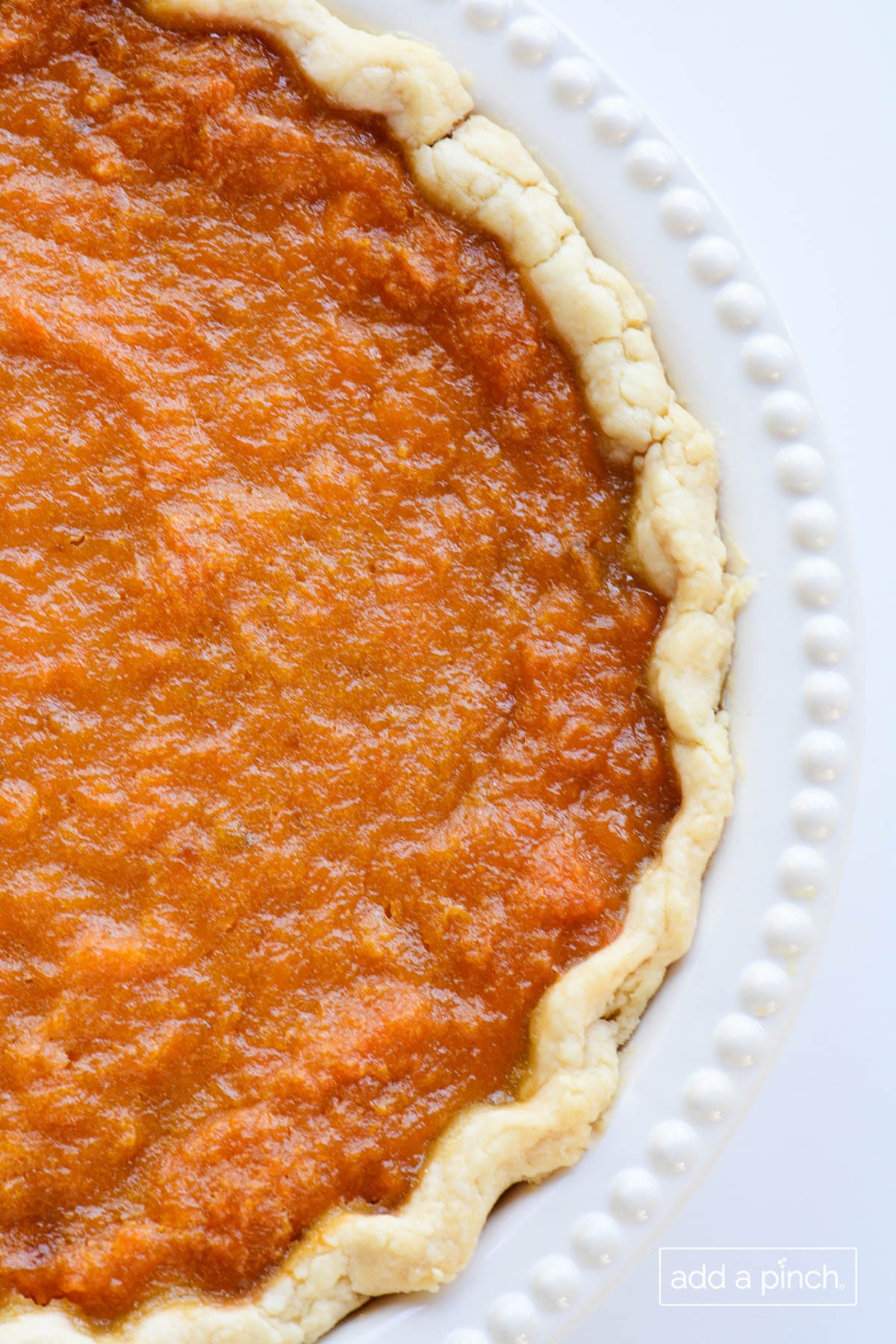
Making the Dough by Hand or Food Processor?
Some people swear by a food processor for making pie dough, others use a pastry cutter, while my Grandmother only used two forks. I have used all methods but use my pastry cutter most often. It’s so easy – any of these methods you prefer works!
How to Make Pie Crust with a Food Processor
- Add flour, butter, shortening, and salt to the bowl of a food processor fitted with a steel blade.
- Pulse 8 to 10 times to combine the flour mixture until the butter and shortening are the size of peas.
- Add the ice water, a tablespoon at a time, through the feed tube and pulse to combine. Repeat until the pie dough begins to form a ball.
- Remove the pie dough ball from the food processor and proceed with the recipe as instructed.
How to Blind Bake Pie Crust
If you are making a pie that requires a pre-baked crust, once you have transferred the pie dough to the pie plate, use a fork and lightly prick the bottom and sides of the pie crust.
- Top the pie dough with foil or parchment paper and fill with pie weights or dried beans.
- Preheat oven to 425 degrees F and bake for about 8 minutes.
- Remove from the oven and allow to cool. Remove the pie weights to use again, and discard the foil or parchment paper.
How to Make a Double-Crust Pie
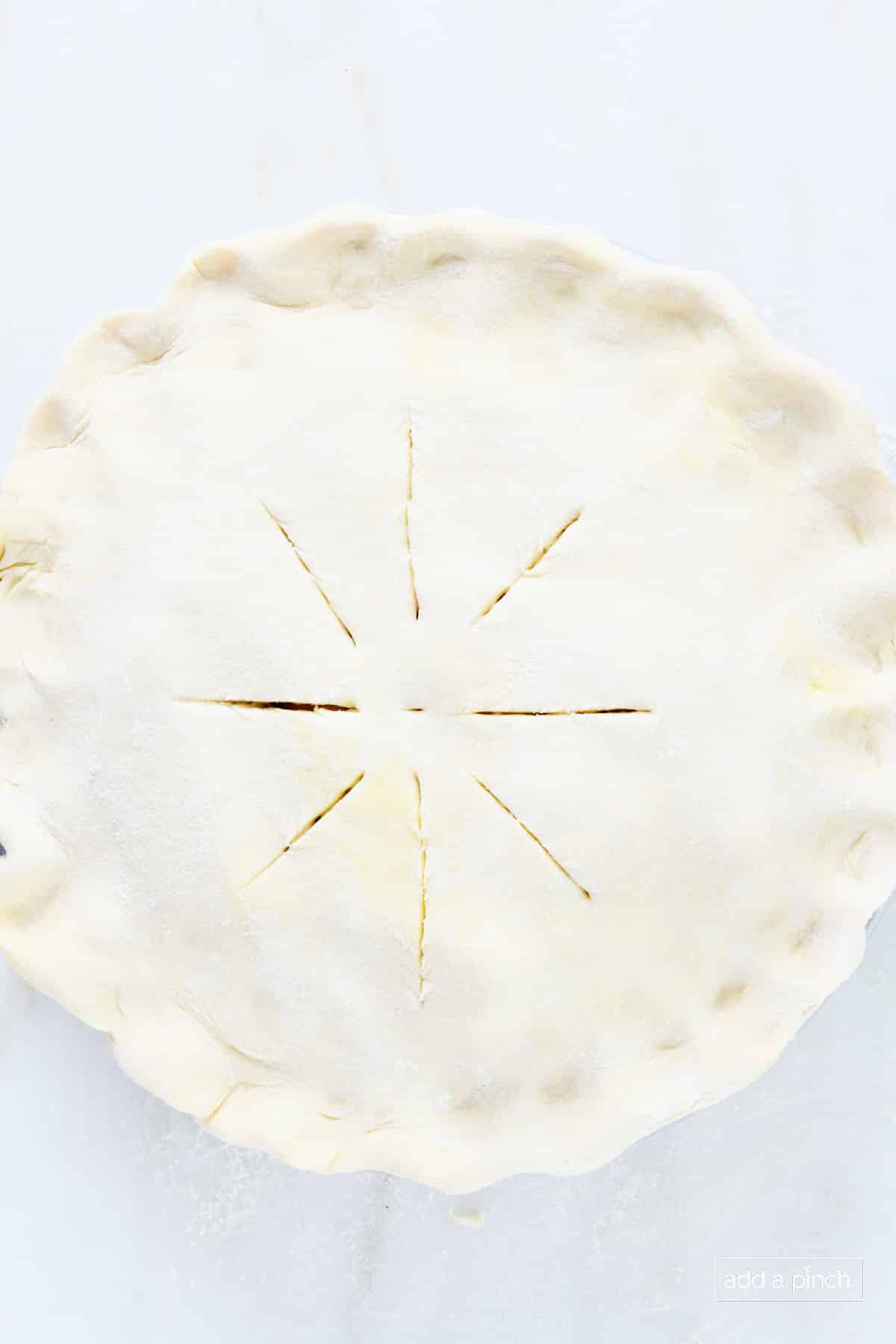
If you are making a pie that needs a double crust, like my apple pie or turkey pot pie, double the recipe for pie crust. As mentioned, place the bottom crust on the pie plate and freeze. Roll out the second or top pie crust dough and put it onto a piece of parchment paper on a baking sheet. Then, place it in the refrigerator to chill for at least 30 minutes up to overnight.
To bake, preheat the oven according to the pie’s recipe directions. Remove the pie plate from the freezer and add the pie filling. Remove the top pie crust from the refrigerator and place on top of the pie filling. Cut slits into the top crust to allow for steam to escape as the pie bakes. Bake according to the recipe instructions.
How to Make a Lattice Pie Crust
If you are making a pie that needs a lattice pie crust, like my peach pie, double the recipe for pie crust. As mentioned, place the bottom crust on the pie plate and freeze. Roll out the second or top pie crust dough and cut into 1-inch slices. Place the slices onto a piece of parchment paper on a baking sheet. Then place it in the refrigerator to chill for at least 30 minutes up to overnight.
To bake, preheat the oven according to the recipe directions. Remove the pie plate from the freezer and add the pie filling. Remove the pie crust dough strips from the refrigerator and place them on top of the pie filling in a woven pattern to form a lattice topping. Bake according to the recipe instructions.
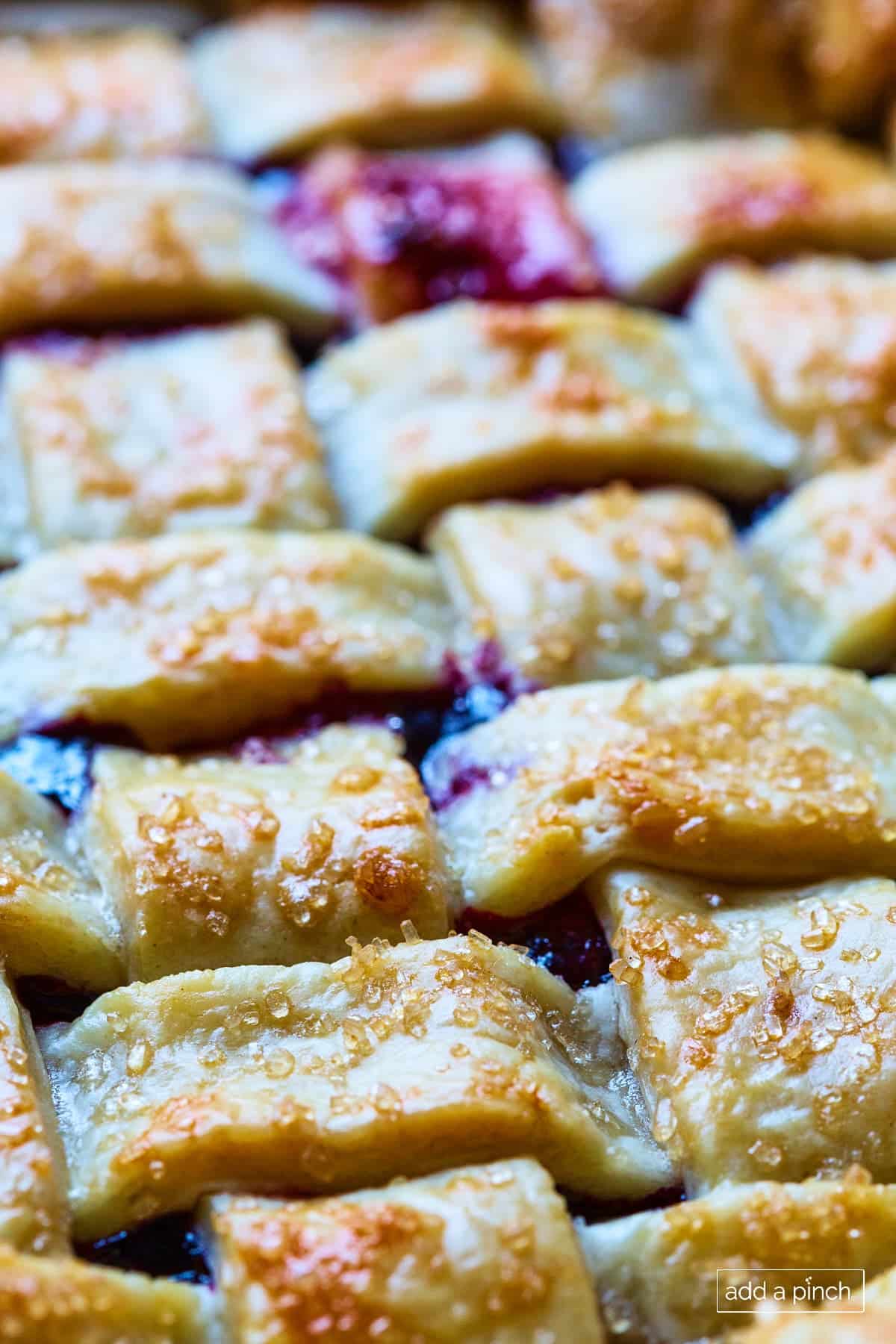
Pie Crust Troubleshooting 101
What to Do When Pie Dough is Dry
When made by hand, each time you add a tablespoon of water, squeeze a tiny bit of the dough between your fingers to see if it holds together. If it does, test another small piece that isn’t as visibly moist. If it does not hold together, continue to add ice-cold water by the tablespoon.
What to Do When Pie Crust is Tough
Overmixing will cause your crust to be tough. Only mix your butter and shortening into the flour mixture until the fats are about the size of peas at the smallest. Then, when adding the ice-cold water, stir until the flour mixture holds together as described in the notes if your pie dough is dry.
What to Do When Pie Crust is Not Flaky
I specifically call for cold butter, cold shortening, and ice-cold water to help make the crust flaky. Freezing it for 30 minutes before adding the filling for baking also allows for the flakiest crust!
The Perfect Crust Every Time
I’ve tested this perfect pie crust recipe so many times over the years and know this recipe works with all pie fillings I’ve tried and can be made by hand fairly quickly. It always provides a flavorful, flaky pie crust sturdy enough for heavy pie fillings.
In other words, this is the perfect pie crust and the only recipe you’ll ever really need. It is perfect for sweet, custard, fruit, and savory pies.
Be sure to watch us make this easy recipe in the video below.
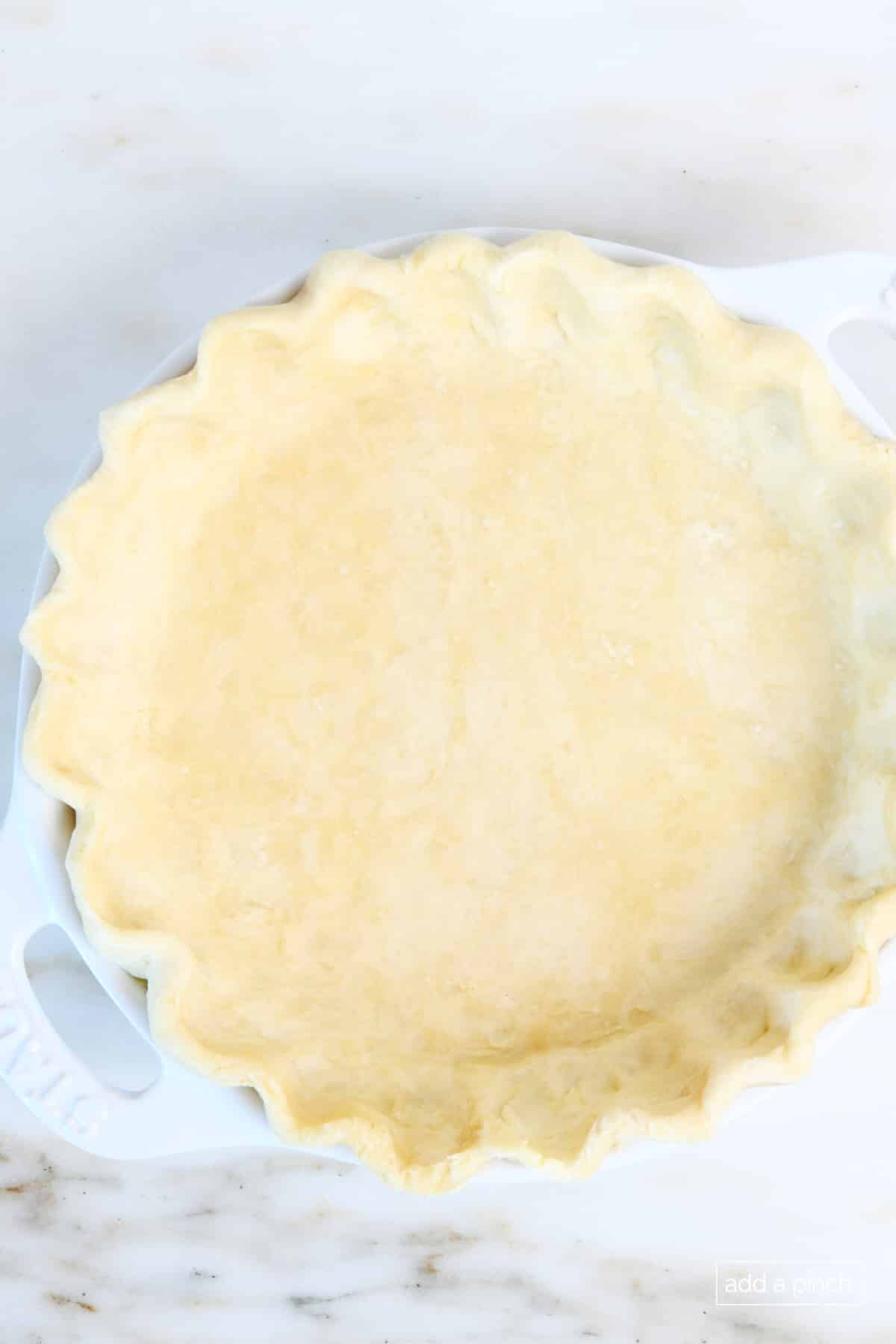
Frequently Asked Questions
The debate exists on using butter, shortening, lard, or some combination for the flakiest, best-tasting pie crust. I like a combination of butter and shortening for pie crusts. The shortening helps it to be super flaky, tender, and sturdy, while the butter gives it a delicious buttery flavor. The combination results in a delicious, flaky, yet perfectly sturdy crust that works for even heavier pie fillings.
Cold fats in your pie dough are a must! It helps the crust to be flaky, tender, and so delicious when the bits of cold butter and shortening melt in the hot oven as the crust bakes. If butter and shortening are too warm in the crust before baking, it can be hard, greasy, and even crumbly.
Absolutely, and I do! You’ll find this crust in my quiche recipe and another savory pie favorite – tomato pie!
Favorite Pie Recipes
Classic Pumpkin Pie
Best Pecan Pie
French Silk Pie
Coconut Cream Pie
Cherry Pie
Here’s my basic pie crust recipe. I think you’ll love it for all sorts of delicious pies. It is a definite must-make recipe!

Pie Crust Recipe
Ingredients
- 1 1/2 cups (180 g) all-purpose flour
- 1/2 teaspoon (1.3 g) kosher salt
- 1/4 cup (46 g) shortening, cold
- 1/4 cup (56.5 g) butter , cold, plus more for buttering pie plate or skillet
- 4-5 tablespoons (57-71 g) ice water
Instructions
- Butter a 9-inch pie plate or skillet and set aside.
- In a large bowl, combine the flour and the salt. Cut in the shortening and butter with a pastry cutter or two forks until the mixture resembles a coarse meal.
- Gradually add enough ice water to the mixture while mixing with a wooden spoon until a ball of pie dough is formed.
- Pour the pie dough onto a lightly floured sheet of plastic wrap and form into a disc. Lightly flour the top of the pie dough and place another sheet of plastic wrap on top. Rolling from the center, roll until the dough is about a 1/8-inch thickness. Remove the bottom piece of plastic wrap, fold the dough over and lay across the pie plate and remove the top piece of plastic wrap. Press the pie dough lightly into the bottom and sides of the pie plate. Crimp the edges of the pie dough. Cover the pie plate with a piece of the plastic wrap and place in the freezer for at least 30 minutes to overnight.
- If pre-baking, use a fork and lightly prick the bottom and sides of the pie dough.Then preheat the oven to 425º F and bake the pie crust for about 8 minutes.
- If not pre-baking, simply fill the pie crust with pie filling and bake according to instructions for the pie recipe.
Notes
Video
Nutrition
Nutrition information is automatically calculated, so should only be used as an approximation.
Enjoy!
Robyn xo
Originally published 2012.
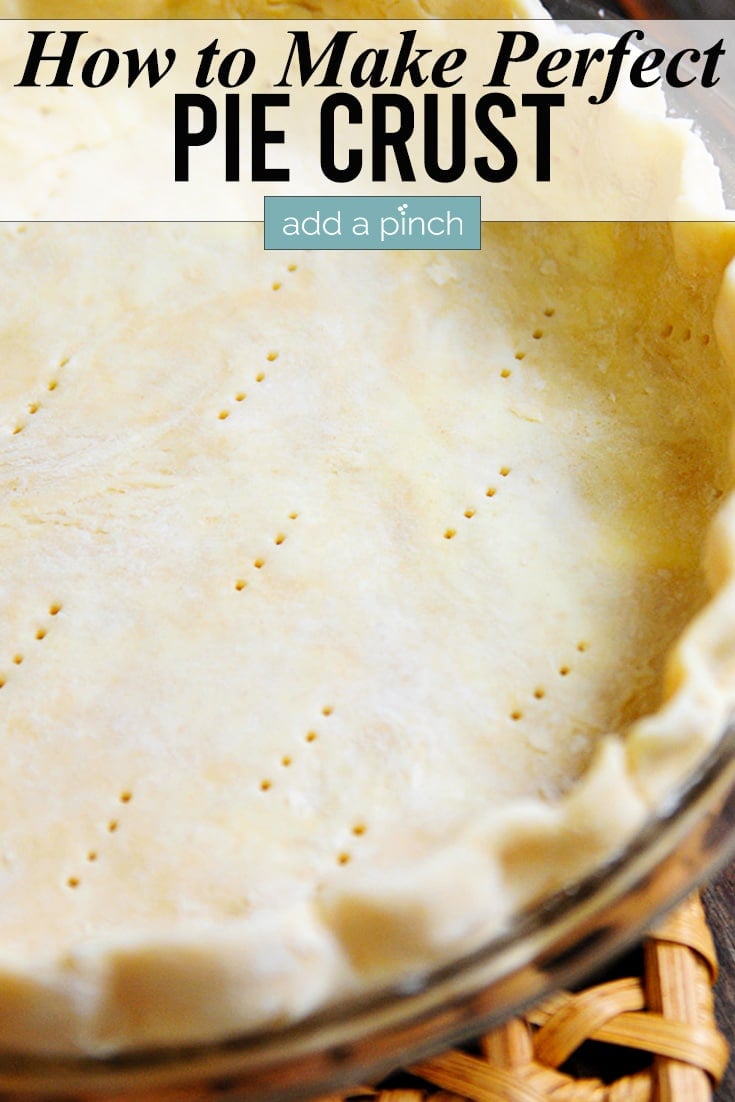

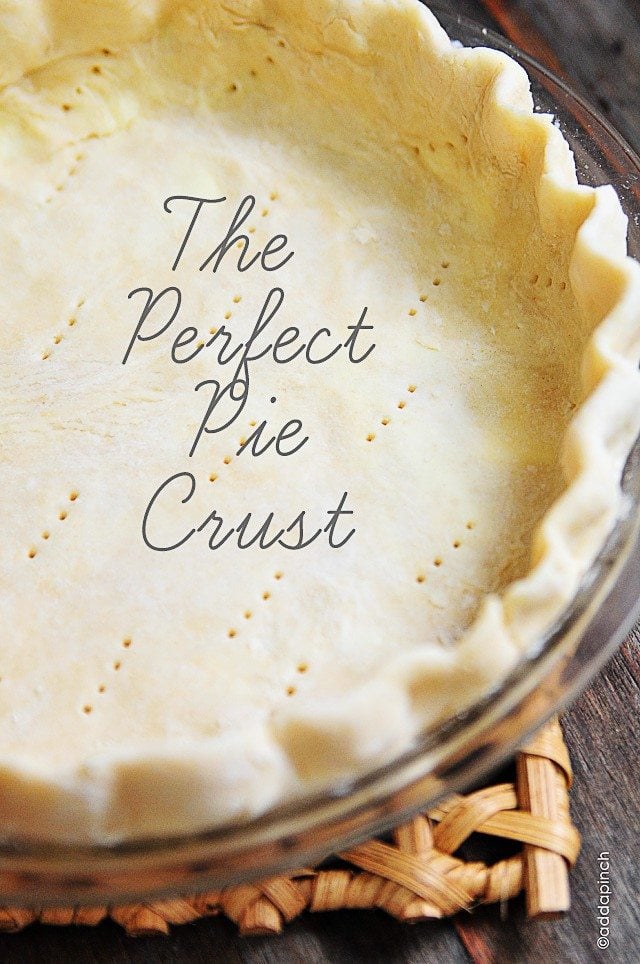

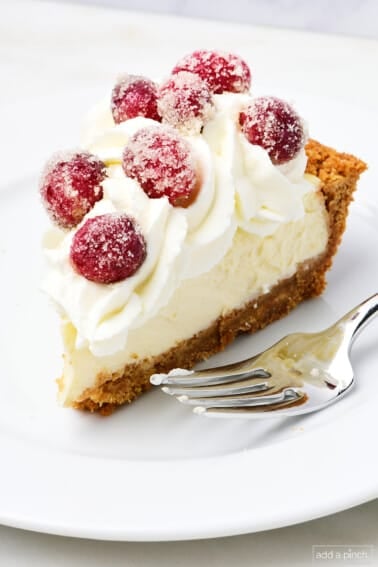

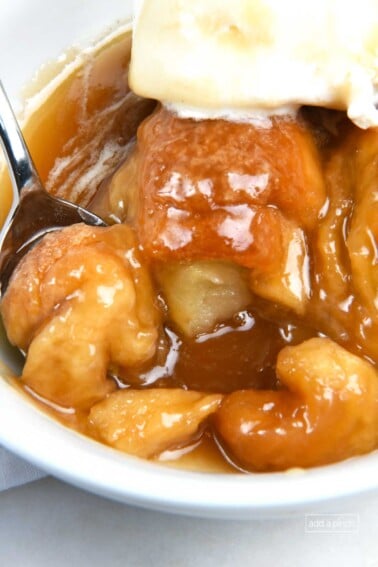
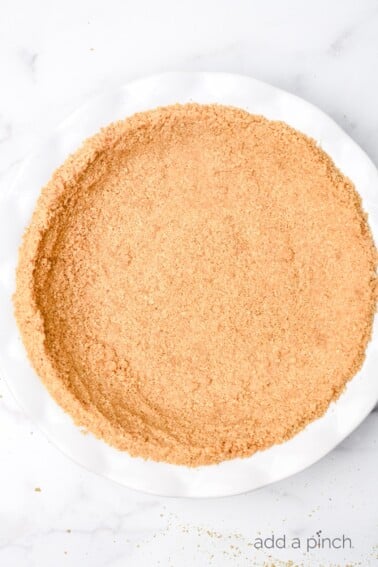
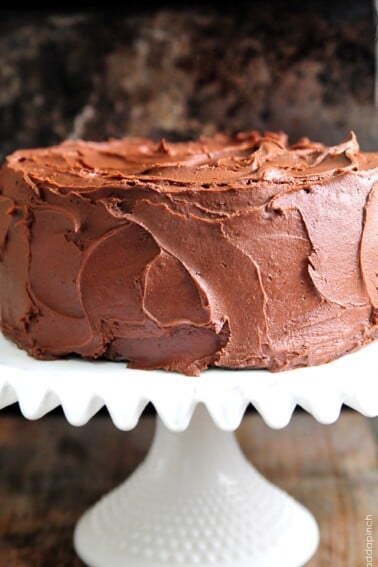
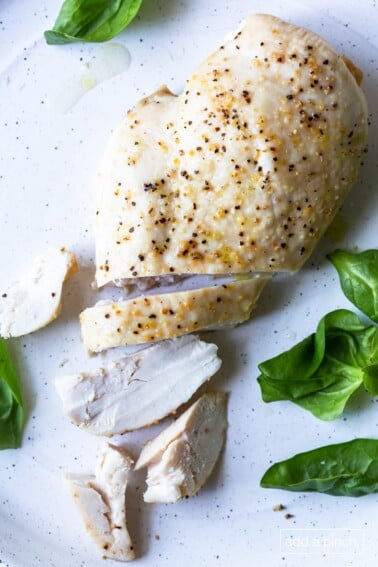
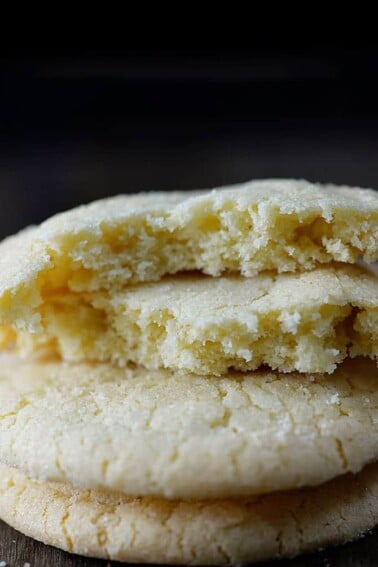

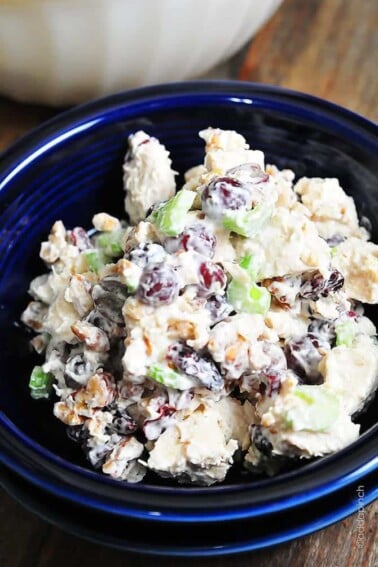










I would only use crisco as I hate butter. What about how to do it for fried pies?
Can lard be substituted for the vegetable shortening? I have been making the Tenderflake recipe since I started making pies, but am looking for a really good recipe for just 2-3 pie shells rather than 6. This recipe sounds rich in flavour, which interests me, but I fear going outside of my lard comfort zone haha. Thanks in advance!
Hi Madeline,
Yes, you can absolutely use lard in this recipe. I hope you enjoy it!
I’ve read the previous questions and your answers in the comment section but, I’m still not clear about the freezer part if you are making a double crusted pie. I read what you do with the top crust in regards to wrapping it with parchment paper and plastic wrap but, do you place it in the freezer at this point? If you do, will the crust be soft enough to seal the the edges?
I found the bottom crust too hard to fold over the top one after placing it in the freezer. Your suggestions?
i have crisco butter flavor shortening do I still need to use butter along with the butter flavor shortening or will it be to much?
Hi Chelsea,
You should be fine to use all butter flavor shortening rather than the shortening and butter.
I have 10″ pie plates. How do I adapt this recipe for the larger size pans?
I have 10 inch pie tins. How do I adjust your pie crust recipe to fit my pie tins? The 9 inch recipe does not give me enough dough to make a pretty crust.
So if you make a double crust, what do you do about freezing the top crust? the bottom is in the pie plate. This is much like my Mom’s crust, but she only used shortening. Hers was maybe 1/16 of an inch thick and I have never been able to roll mine that thin. We make Cornish Pasties, and she would normally put 2 crusts in one pie tin. Meaning place one crust in the pie tin and put in a cup of the meat and potato mixture…fold that in half and flute it…and then lay another crust beside that and fill it and fold over and flute that one. So you basically have 2 half pies in one pie tin (or glass plate if you prefer). then brush with egg or butter on top for a nice brown crust. her crust was so light and flaky…amazing. I have never been able to duplicate that 🙁
Hi Sara,
If I’m making a double crust pie, I will put the bottom crust in the pie plate as in the recipe instructions and then wrap the top crust tightly in parchment paper and plastic wrap to make sure it is airtight so it doesn’t dry out. I hope that helps!
I love how your mom made hers! What a great idea!
I take it, you just double it if making a two crust pie. Your recipe is very similar to one my Grandma and Mom used.
This recipe yields one 9-inch pie crust recipe. So, if you were baking a double crust type of pie, you would need to double it. I hope that helps!
I like to bake & Love to try a Blue Berry Pie.
Hey Patricia HALKETT when you are using frozen or fresh blue berries shred a green apple in it while you are thickening the berries on top of the stove it adds a nice fresh flavor to the berries without changing the blue berry flavor it enhances it . it adds pectin to the filling so it doesn’t turn out like jelly.
I have probably made this pie crust six times over the last few weeks and it turns out great each time. I made your apple pie and was asked to make it over and over again 🙂
What can I substitute for shortening. Is this recipe a flaky crust..?